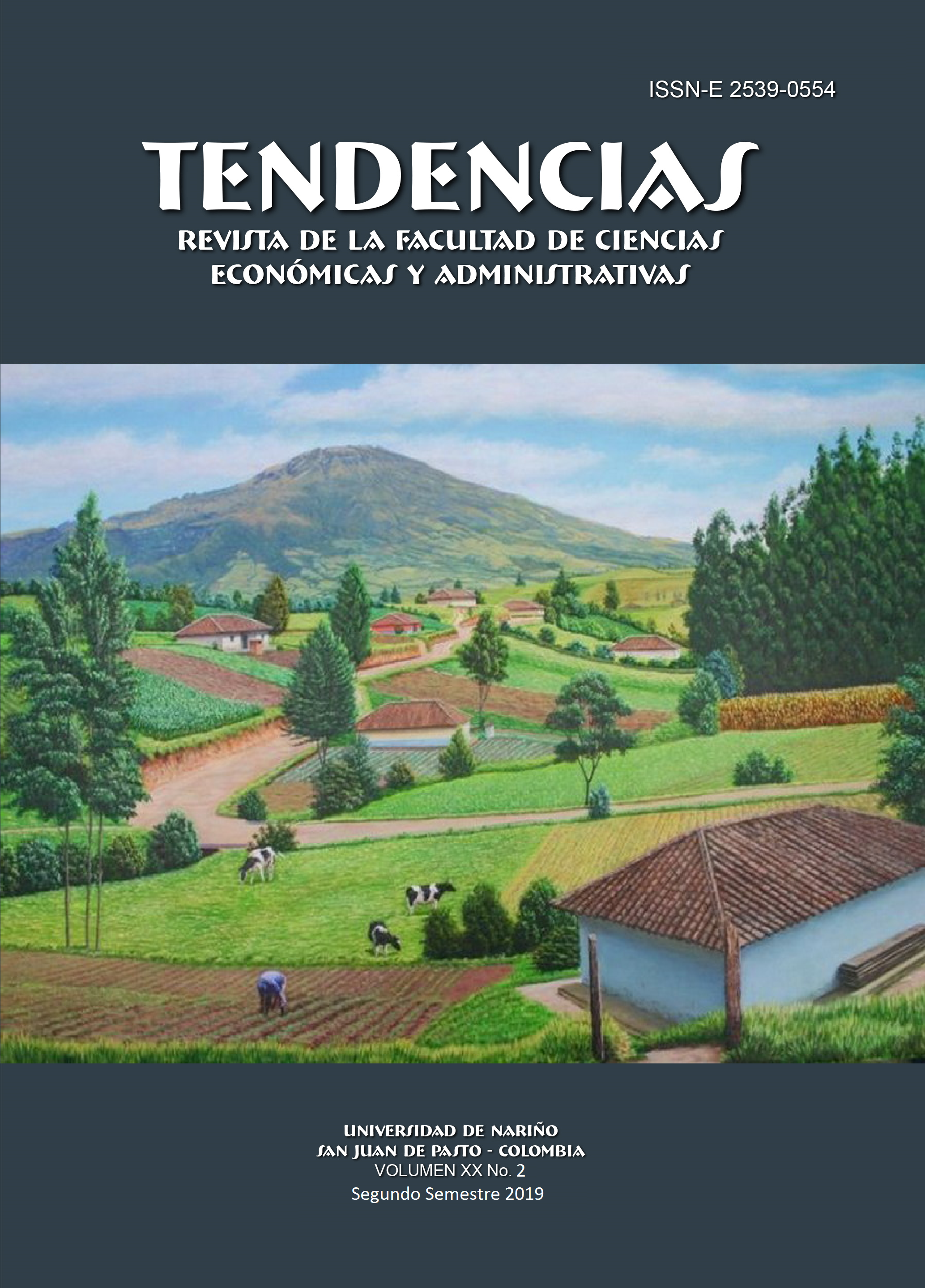The olfative marketing as positioning of brands
DOI:
https://doi.org/10.22267/rtend.192002.123Keywords:
sensory marketing, olfactory marketing, olfactory merchandising, note, scentAbstract
The objective of this study based on analyzing the perception that consumers have about olfactory sensory marketing, as a strategy used for brand positioning.
The sense of smell has always been a determining factor in human decision making, however, the studies that exist on the process that links aromas, smell and brands. They are descriptive and internal in nature for the reason they cannot confirm that a strategic aroma, applied to a company or brand is an effective positioning factor.
Some brands already use the sense of smell as an activator of relationships, emotions and feelings with their customers, taking advantage of the sense of smell does not present advertising saturation, and has direct communication with memory, however, it is an isolated strategy that migrates from other countries and that for most companies it is a new concept as a sensory marketing application.
An exploratory quantitative investigation carried out using surveys applied to (120) consumers, between men and women between the ages of 18 and 60, with purchase and consumption processes in the Colombian territory.
The findings relate positively to the consumer and the aromas, it can also be evidenced how novel the olfactory marketing concept is for the market, confirming that some consumers do know these types of strategies, and have experienced it in large brands, such as hotels, restaurants and clothing sector.
As conclusions can be evidenced a willingness on the part of consumers in the implementation of olfactory sensory strategies for brands. Turning this into an interesting market opportunity for companies, developers and distributors of olfactory marketing, since the consumer in general is willing to enjoy the olfactory sensory strategy.
Downloads
References
(1) Alzate, M; & Luján, D. (2017). Psicología y marketing olfativo : una exploración desde la psicología sobre el impacto que ejerce en el consumidor el uso de odotipos. Recuperado de: http://200.24.17.74:8080/jspui/handle/fcsh/1117
(2) Arboleda, A; & Alonso, J. (2015). El aroma al evaluar el involucramiento del consumidor con un producto y su percepción de calidad. Estudios Gerenciales, 31(137), 403–410. https://doi.org/10.1016/j.estger.2015.07.003
(3) Avendaño C; Paz, G; Rueda, L; Avendaño, W; Paz, L; & Rueda, G. (2015). Estímulos auditivos en prácticas de neuromarketing. Caso: Centro Comercial Unicentro, Cúcuta, Colombia. Recuperado de: www.unicentrocucuta.com
(4) Bonadeo, B. (2011). Odotipo. Recuperado de: www.austral.edu.ar
(5) Bonadeo, M. (2005). Odotipo : historia natural del olfato y su función en la identidad de marca. Universidad Austral, Facultad de Comunicación.
(6) Calabretti, A; Gabrielli, L; Vesnaver, R; Bader, S; & Verderio, S. (2006). Il marketing olfattivo: Nuova frontiera del packaging alimentare. Industrie Alimentari, 45(464), 1282–1284.
(7) Cuatrecasas, L. (2017). El efecto del aroma en la intención de compra de un paquete vacacional. Anuario Electrónico de Estudios En Comunicación Social “Disertaciones,” 11(1), 150. https://doi.org/10.12804/revistas.urosario.edu.co/disertaciones/a.5004
(8) De Garcillán, M. (2015). Persuasión a través del marketing sensorial y experiencial. Opción, 31(2), 463–478. Recuperado de: http://www.redalyc.org/html/310/31045568027/
(9) Díez, E; Landa, F; Cossío, F; & Zorrilla, M. (1996). Merchandising. Recuperado de: http://soda.ustadistancia.edu.co/enlinea/3momento_admoncomercialymercadeo_dianaospina/el_merchandising.html
(10) Fuentes, A; Fresno, M; Santander, H; Valenzuela, S; Gutiérrez, M; & Miralles, R. (2011). Sensopercepción olfatoria: Una revision. Revista Medica de Chile, Vol. 139, pp. 362–367. https://doi.org/10.4067/S0034-98872011000300013
(11) Gaby, J; & Tepper, B. (2019). A Comparison of Hedonic and Emotional Responses to Common Odors Delivered by qPODs (Portable Olfactive Devices) and Traditional Sniff Jars. Food Quality and Preference, 103804. https://doi.org/10.1016/j.foodqual.2019.103804
(12) Gómez, C; Manzi, M; & Galindo, T. (2014). El scent marketing: una revisión bibliográfica.
(13) Gómez, C; Andres, M; Puertas, M; & Galindo, T. (s.f.). El scent marketing: una revisión bibliográfica Scent marketing: a bibliographic review.
(14) Hernández, M; Tomaseti, E; & Miranda, E. (2016). Marketing olfativo: la influencia del olor sobre la memoria. Anuario de Jóvenes Investigadores, (9), 244–247. Recuperado de: https://dialnet.unirioja.es/servlet/articulo?codigo=5981388
(15) Hernández, R; Fernández, C; & Baptista, P. (2006). Metodología de la investigación. Recuperado de: https://www.studocu.com/en/document/instituto-tecnologico-de-veracruz/politicas-publicas/book-solutions/sampieri-metodologia-de-la-investigacion-4ta-edicion-sampieri-2006-ocr/2248528/view
(16) Hummel, T; Sekinger, B; Wolf, S; Pauli, E; & Kobal, G. (1997). “Sniffin” sticks’. Olfactory performance assessed by the combined testing of odor identification, odor discrimination and olfactory threshold. Chemical Senses, 22(1), 39–52. https://doi.org/10.1093/chemse/22.1.39
(17) Krishna, A; & Schwarz, N. (2014). Sensory marketing, embodiment, and grounded cognition: A review and introduction. Journal of Consumer Psychology, 24(2), 159–168. https://doi.org/10.1016/j.jcps.2013.12.006
(18) Mascaraque, L; & Ramón, A. (2017). El olfato. Recuperado de: https://www.digitaliapublishing.com/visor/49514
(19) Ovejero, A. (1993). La teoría de la disonancia cognitiva. Psicothema, 5(1), 201–206. Recuperado de: http://www.redalyc.org/articulo.oa?id=72705116
(20) Pereda, P. (2015). Arte de la guerra de Sunzi. Revista de Artes Marciales Asiáticas, 3(4), 81. https://doi.org/10.18002/rama.v3i4.394
(21) Revisi, C. (2011). Neuroepitelio olfatorio. 362–367.
(22) Schmitt, B. (1999). Experiential marketing castellano. Libro, 15(1–3), 1–17. Recuperado de: http://www.ucipfg.com/Repositorio/MGTS/MGTS14/MGTSV-09/materialesnuevos/semana4/MercadeoVivencial-ExperientialMarketing.pdf
Published
How to Cite
Issue
Section
License
Those authors who have publications with this journal, accept the following terms:
This journal is licensed under a Creative Commons Reconocimiento-NoComercial 4.0 Internacional License. The articles can be copied, distributed, adapted and communicated publicly, as long as the credits of the work are recognized and the respective source is quoted. This work can not be used for commercial purposes.
To increase their visibility, documents are sent to databases and indexing systems.
The content of the items is the responsibility of each author, and does not compromise in any way, journal or institution.







































